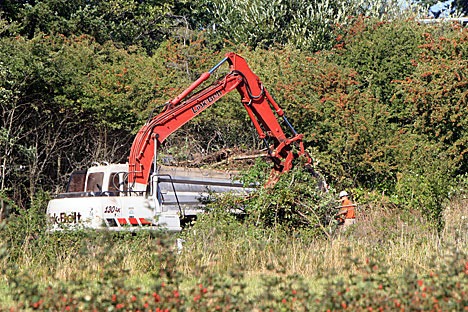The latest public works’ project on Orcas Island has excavators uprooting trees, tearing out stands of shrubbery and creating a huge swath of broken soil behind the Village Green bandshell to build a constructed wetland for stormwater treatment.
Some wonder if this really an improvement, noting an existing wetland indicated on county maps.
“No one will set foot in that wetland,” said Shannon Wilbur, the county’s senior project engineer, saying the professionally delineated wetland comprises just 15 to 20 percent of the .93-acre property, and won’t be disturbed.
Wilbur said current non-natives like blackberry, hawthorne and holly will be replaced with high-uptake capacity native species, including cedar, fir, flowering dogwood, vine maple, nootka rose, salmonberry, huckleberry, ferns, bleeding heart, larkspur, camas, sedges, rushes and water parsley – nearly 6,000 plants. The constructed wetland will provide treatment for 40 percent of Eastsound’s runoff, with a treatment capacity of 370,000 gallons or 1.13 acre-feet at a time. It will be finished in October, and monitored by the county as it matures over the winter. It should be ready to receive piped runoff from “A” and Fern Streets in the winter of 2013.
At present, two main pipes collect stormwater from the commercial core of Eastsound and discharge it through a single 55-inch outfall into Fishing Bay at the north end of East Sound.
The antiquated system provides no treatment, and it shows: the sound is considered “polluted” based on the state’s Clean Water Act surface water quality standards, with low dissolved oxygen and sensitivity to stratification and eutrophication.
“High fecal coliform levels, total suspended solids and temperature have been found in stormwater water samples collected in Eastsound,” stated the county’s application for the EPA grant now funding the project. “A 2009 study discovered pesticides levels in clams collected near Eastsound’s stormwater outfall that are above federal food standards.”
The 2,238-acre Fishing Bay/Ship Bay drainage basin includes Eastsound village and covers 1230 parcels. An untyped stream running north to south through both of Eastsound’s major wetlands finds its outlet in Fishing Bay. Wilbur said the new wetland won’t treat all of Eastsound’s runoff because there just isn’t enough space.
An 18,700-cubic foot drainage basin in the wetland will provide primary treatment as particulate matter settles out; then the water will be filtered by an installment of new plants specifically chosen for their ability to remove pollutants; finally, the water will filter through the soil, presumably recharging Eastsound aquifers instead of being shunted into the sea.
Located just south of SeaView Theater, tax parcel #271413011000, the project site was purchased by the county in 1994 for stormwater treatment. The wetland was designed in 2006, but not funded until the 2010 EPA grant was secured.
County modifications of its initial plans in response to aesthetic review committee advice include a shallower settling pond with no bridge or safety fence, retaining a few mature trees, and rerouting the proposed walking path to loop 600 feet around the perimeter of the wetland.
The final version of the plans is online here.




